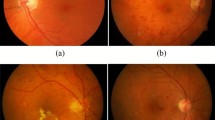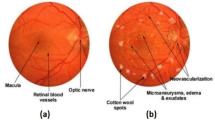Abstract
Hypertension retinopathy is a retinal disease caused due to hypertension which leads to vision loss and blindness. Ophthalmologists use clinical methods to perform the diagnosis, which takes more time and money. Still, the computer-aided diagnostic system detects and grades Hypertensive Retinopathy with no time and is less expensive. This paper introduces an automated system that identifies hypertension retinopathy in the early stage of hypertension. Retinal image segmentation efficiently detects eye ailments, which are the signs of major eye diseases caused by hypertension, diabetes, and age-related macular disorders. This study uses fuzzy logic techniques in digital image processing and mainly concentrates on the early detection of hypertension retinopathy by using a nature-inspired optimization algorithm. Improved Fuzzy C-Means clustering identifies the lesion regions in hypertensive retinopathy accurately. The present model is tested on the publicly available online dataset, and its outcomes are compared with distinguished published methods. This study calculates the segmented output on the optimized features using the improved loss function in the Resnet-152 model. The proposed approach improves performance and surpasses the existing state-of-the-art models.








Similar content being viewed by others
Data availability
Data sharing not applicable to this article.
References
Abbas Q, Ibrahim MEA (2020) Densehyper: an automatic recognition system for detection of hypertensive retinopathy using dense features transform and deep-residual learning. Multimed Tools Appl 79(41):31595–31623
Abbasi UG, Akram MU (2014) Classification of blood vessels as arteries and veins for diagnosis of hypertensive retinopathy. In 2014 10th International Computer Engineering Conference (ICENCO), pages 5–9. IEEE
Aggarwal AK (2022) Biological Tomato Leaf disease classification using deep learning framework. Int J Biol Biomed Eng 16(1):241–244
Agurto C, Joshi V, Nemeth S, Soliz P, Barriga S (2014) Detection of hypertensive retinopathy using vessel measurements and textural features. In 2014 36th annual international conference of the IEEE engineering in medicine and biology society, pages 5406–5409. IEEE
Akbar S, Akram MU, Sharif M, Tariq A, Khan SA (2018) Decision support system for detection of hypertensive retinopathy using arteriovenous ratio. Artif Intell Med 90:15–24
Akbar S, Akram MU, Sharif M, Tariq A, Yasin UU (2018) Arteriovenous ratio and papilledema based hybrid decision support system for detection and grading of hypertensive retinopathy. Comput Methods Programs Biomed 154:123–141
Arasy R, Basari (2019) Detection of hypertensive retinopathy using principal component analysis (pca) and backpropagation neural network methods. In AIP Conference Proceedings, volume 2092, page 040002. AIP Publishing LLC
Arsalan M, Haider A, Choi J, Park KR (2021) Diabetic and Hypertensive retinopathy screening in fundus images using artificially intelligent shalow architectures. J Person Med 12(1):1–7
Arsalan M, Haider A, Lee YW, Park KAR (2022) Detecting retinal vasculature as a key biomarker for deep learning based intelligent screening and analysis of diabetic and hypertensive retinopathy. Exp Syst Appl 200:117009
Badawi SA, Fraz MM, Shehzad M, Mahmood I, Javed S, Mosalam E, Nileshwar AK (2022) Detection and grading of hypertensive retinopathy using vessels tortuosity and arteriovenous ratio. J Digit Imaging 35(2):281–301
Bezdek JC (2013) Pattern recognition with fuzzy objective function algorithms. Springer Sci Bus Med
Bhimavarapu U, Battineni G, Chintalapudi N (2023) Improved optimization algorithm in LSTM to predict crop yield. Computers 12(1):1–19
Bimavarapu U (2022) Fuzzy LSTM to predict air quality with improves activation function. Int J Fuzzy Syst:1–16
Bimavarapu U (2022) IRF-LSTM: enhanced regularization function in LSTM to predict the rainfall. Neural Comput Applic 1(1):1–11
Chatterjee S, Chattopadhya S, Hope-Ross M, Lip PL (2002) Hypertension and the eye: changing perspectives. J Hum Hypertens 1,16(10):667–675
Faheem MR et al (2015) Diagnosing hypertensive retinopathy through retinal images. Biomed Res Ther 2(10):1–4
Feng, S, Zhou, Z, Pan, D, Tian, Q (2019) CCnet: A cross connected convolutional network for segmenting retinal vessels uisng multiscale features. Neurocomput
Henderson AD, Bruce BB, Newman NJ, Biousse V (2011) Hypertension-related eye abnormalities and the risk of stroke. Rev Neurol Dis 8(1–2):1
Irshad S, Ahmad M, Akram MU, Malik AW, Abbas S (2016) Classification of vessels as arteries verses veins using hybrid features for diagnosis of hypertensive retinopathy. In: 2016 IEEE International Conference on Imaging Systems and Techniques (IST) 1(1):472–475
Kaur A, Chauhan AS, Kumar Aggarwal A (2022) Preduction of enhancers in DNA sequence data uisng a hybrid CNN-DLSTM model. IEEE/ACM Trans Comput Biol Bioinform 1(1):1–10
Khitran S, Akram MU, Usman A, Yasin U (2014) Automated system for the detection of hypertensive retinopathy. In: 2014 4th international conference on image processing theory, tools and applications (IPTA) 1(1):1–6
Khitran S, Akra, MU, Usma, A, Yasin U (n.d.) Automated system for the detection of hypertensive retinopathy. In: International Conference on image processing theory, tools and applications (IPTA 2014) 1(1):1–6
Kiruthika M, Swapna TR, Santhosh KC, Peeyush KP (2019) Artery and vein classification for hypertensive retinopathy. In 2019 3rd International Conference on Trends in Electronics and Informatics (ICOEI), pages 244–248. IEEE
Leopold HA, Orchard J, Zelek JS, Lakshminarayanan V (2019) PixelBNN: Augmenting the pixelCNN with batch normalization and the presentation of a fast architecture for retinal vesel segmentation. J Imaging 5(1):26
Manikis GC, Sakkalis V, Zabulis X, Karamaounas P, Triantafyllou A, Douma S, Zamboulis C, Marias K (2011) An image analysis framework for the early assessment of hypertensive retinopathy signs. In 2011 E-health and bioengineering conference (EHB), pages 1–6. IEEE
Manikis GC, Sakkalis V, Zabulis P, Karamaounas A, Triantafyllou A, Douma S, Zamboulis C, Marias K (2011) An image analysis framework for the early assessment of hypertensive retinopathy signs. International conference on E-Health and bioengineering (EHB2011) 1(1):51–57
Mirsharif Q, Tajeripour F, Pourreza H (2013) Automated characterization of blood vessels as arteries and veins in retinal images. Comput Med Imaging Graph 1,37(7):607–617
Mohan, N, Murugan, R, Goel, T (2022) Machine learning algorithms for hypertensive retinopathy detection through retinal fundus images. Appl Acad Press Comput Vis Recog Syst, 39–67
Muhammad A, Muhammad O, Tahir M, Se WC, Kang RP (2019) Aiding the diagnosis of diabetic and hypertensive retinopathy uisng artificial intelligence based semantic segmentation. J Clin Med 8(9):1–15
Muramatsu C, Hatanaka Y, Iwase T, Hara T, Fujita H (2010, computer aided diagnosis) Automated detection and classification of major retinal vessels for determination of diameter ratio of arteries and veins. Med Imaging 7624:153–160
Narasimhan K, Neha VC, Vijayarekha K (2012) Hypertensive retinopathy diagnosis from fundus images by estimation of avr. Procedia Eng 38:980–993
Nirmala SR, Chetia S (2017) Retinal blood vessel tortuosity measurement for analysis of hypertensive retinopathy. In: 2017 International Conference on Innovations in Electronics, Signal Processing and Communication (IESC) 1(1):45–50
Noh KJ, Park SJ, Lee S (2019) Scale-space approximated convolutional neural networks for retinal vessel segmentation. Comput Methods Programs Biomed 178:237–246
Noronha K, Navya KT, Nayak KP (2012) Support system for the automated detection of hypetensive retinopathy using fundus images. International conference on electronic design and signal processing (ICEDSP2012) 1(1):7–11
Ortìz D, Cubides M, Suarez A, Zequera M, Quiroga J, Gòmez JA, Arroyo N (2012) System development for measuring the arterious venous rate (avr) for the diagnosis of hypertensive retinopathy. In 2012 VI Andean Region International Conference, pages 53–56. IEEE
Pal NR, Bezdek JC (1995) On cluster validity for the fuzzy c-means model. IEEE Trans Fuzzy Syst 3(3):370–379
Ross TJ (2005) Fuzzy logic with engineering applications. John Wiley & Sons, New York, 1(1):1–350
Sangwine SJ, Horne REN (2012) The colour image processing handbook. Springer Sci Bus Med
Sankar K, Pal RK et al (1981) Image enhancement using smoothing with fuzzy sets. IEEE Trans Sys Man Cyber 11(7):494–500
Suryani E, Kipti MY et al (2018) Assessment of early hypertensive retinopathy using fractal analysis of retinal fundus image. Telkomnika 16(1):445–454
Syahputra MF, Aulia I, Rahmat RF, et al. (2017) Hypertensive retinopathy identification from retinal fundus image using probabilistic neural network. In 2017 International Conference on Advanced Informatics, Concepts, Theory, and Applications (ICAICTA), pages 1–6. IEEE\
Tan JH, Acharya UR, Bhandary SV, Chua KC, Sivaprasad S (2017) Segmentation of optic disc, fovea and retinal vasculature using a single convolutional neural network. J Comput Sci 20:70–79
Thukral R, Kumar A, Arora AS (2019) Effect of different thresholding techniques for denoising of emg signals by uisng different wavelets. International conference on intelligent communication and computational technqiues (ICCT2019) 1(1):161–165
Triwijo BK, Sabarguna BS, Budiharto WIDODO, Abdurachman E (2021) New hypertensive retinopathy grading based on the ration of artery venous diameter from retinal image. Int J Comput 20(2):221–227
Triwijoyo BK, Pradipto YD (2017) Detection of hypertension retinopathy using deep learning and boltzmann machines. J Phys Conf Ser 801:012039. IOP Publishing, 801(1):1–7
Triwijoyo BK, Budiharto W, Abdurachman E (2017) The classification of hypertensive retinopathy using convolutional neural network. Proced Comput Sci 116:166–173
Ubhi JS, Aggarwal AK (2022) Neural style transfer for image within images and conditional GANS for destylization. J Vi Commun Image Represent 85:103483
Usharani, B (2022) Hypertensive retinopathy classification using improved clustering algorithm and the improved convolution neural network. IGI Global, Deep Learn Appl Cyber Phys Syst, 119–131
Wang C, Zhao Z, Ren Q, Xu Y, Yu Y (2019) Dense U-net based on patch based learning for retinal vessel segmentation. Entropy 21:168
Zhou F, Jia ZH, Yang J, Kasabov N (2017) Method of improved fuzzy contrast combined adaptive threshold in nsct for medical image enhancement. Biomed Res Int 2017:1–10
Author information
Authors and Affiliations
Corresponding author
Ethics declarations
Conflict of interest
No conflict of interest to authors.
Additional information
Publisher’s note
Springer Nature remains neutral with regard to jurisdictional claims in published maps and institutional affiliations.
Rights and permissions
Springer Nature or its licensor (e.g. a society or other partner) holds exclusive rights to this article under a publishing agreement with the author(s) or other rightsholder(s); author self-archiving of the accepted manuscript version of this article is solely governed by the terms of such publishing agreement and applicable law.
About this article
Cite this article
Bhimavarapu, U. Automatic detection of hypertensive retinopathy using improved fuzzy clustering and novel loss function. Multimed Tools Appl 82, 30107–30123 (2023). https://doi.org/10.1007/s11042-023-15044-2
Received:
Revised:
Accepted:
Published:
Issue Date:
DOI: https://doi.org/10.1007/s11042-023-15044-2




